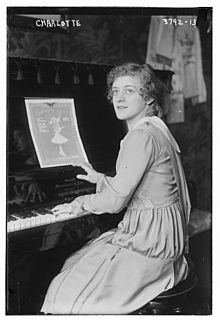| Charlotte Oelschlagel | |
|---|---|
 Charlotte Oelschlagel in 1916 Charlotte Oelschlagel in 1916 | |
| Full name | Charlotte Oelschlagel |
| Other names | Charlotte Hayward |
| Born | (1898-08-14)August 14, 1898 Berlin |
| Died | November 14, 1984(1984-11-14) (aged 86) Berlin |
| Figure skating career | |
| Country | |
Charlotte Oelschlägel, aka Charlotte Hayward (August 14, 1898 – November 14, 1984) was a German professional skater. For most of her life, she used only her first name as her stage name. She invented and first performed the figure skating elements death spiral and Charlotte spiral, which is named after her.
Personal life
Charlotte Oelschlägel was born in Berlin. As well as being a figure skater, she was also a musician. At age seven, she was on stage with the Berlin Philharmonic. She played the mandolin, lute, harp and piano. When she was 10 years old, she had nervous and growing problems. Medications did not help. She was advised to do figure skating to treat her medical problems.
She was married to Curt Neumann, also a figure skater. She died in a retirement home in Berlin on November 14, 1984.
Career
Oelschlägel initially skated with her brother Fritz. Later, she was coached by Paul Münder. She was known professionally by her first name.
In 1910, Oelschlägel began appearing in ice ballets in Berlin. In 1915, she became the first performer to star in a Broadway ice show, appearing in Hip-Hip-Hooray! at the New York Hippodrome. She was also the first skater to star in a motion picture, the American drama film The Frozen Warning (1916), which figure skating historian James R. Hines calls "the first motion picture to include figure skating". According to figure skater writer and historian Ellyn Kestnbaum, Oelschlägel "brought skating into the conventions of specularized femininity that characterized early-twentieth-century popular entertainment".
In the 1920s, Oelschlägel and Neumann developed the death spiral and the move named for her, the Charlotte spiral (also called the "fadeout"), "a back spiral with the upper body leaning toward the skating foot and the free leg lifted to almost 180 degrees". These moves advanced the development of the use of flexibility in figure skating which, as Kestnbaum states, "generally favor a female rather than a male physique".
In 1929, she appeared for the last time in a United States show in Cincinnati, Ohio. In 1939, her professional figure skating career ended due to the beginning of World War II. Her passport was confiscated by the Nazis. After the war, she worked as a coach at the club Grunewalder TC. She retired in 1976. She was inducted into the World Figure Skating Hall of Fame in 1985. She has been called "figure skating's first major theatrical star".
References
- Kestnbaum, Ellyn (2003). Culture on Ice: Figure Skating and Cultural Meaning. Middleton, Connecticut: Wesleyan Publishing Press. p. 102. ISBN 0-8195-6641-1.
- ^ Hines, James R. (2011). Historical Dictionary of Figure Skating. Lanham, Maryland: Scarecrow Press. p. xxii. ISBN 978-0-8108-6859-5.
- Barron, James (December 21, 2017). "Where Winter's Silver Skates Warmed the Soul". The New York Times. Retrieved March 4, 2021.
- Kestnbaum, pp. 102—103
- ^ Kestnbaum, p. 103
- World Figure Skating Museum and Hall of Fame Members
- Pirouette, 1995, numbers 5 and 6
External links
This article about a German figure skater is a stub. You can help Misplaced Pages by expanding it. |